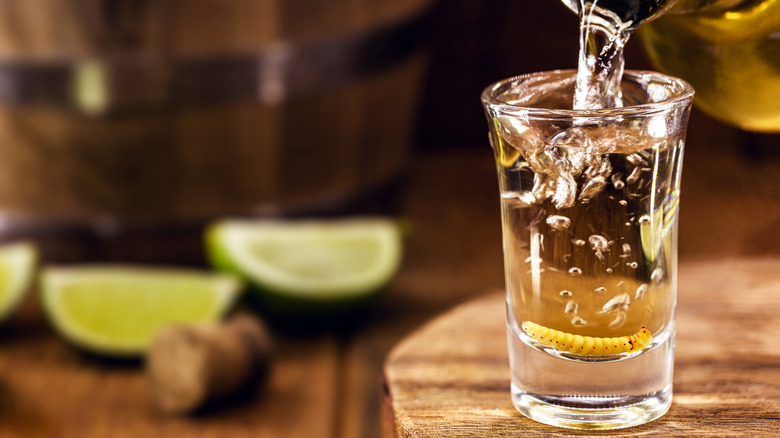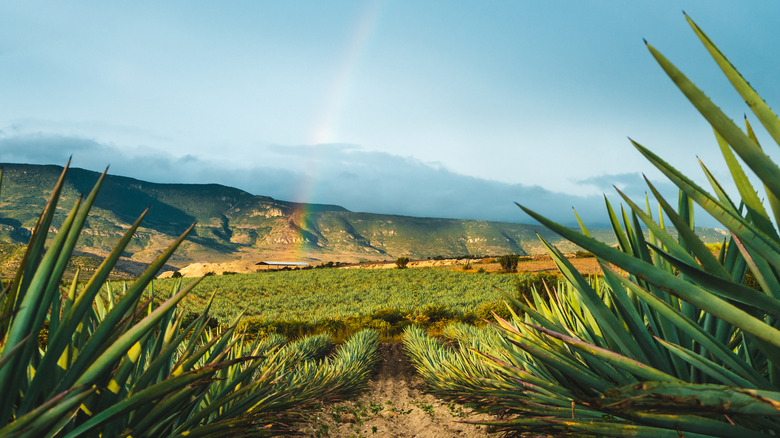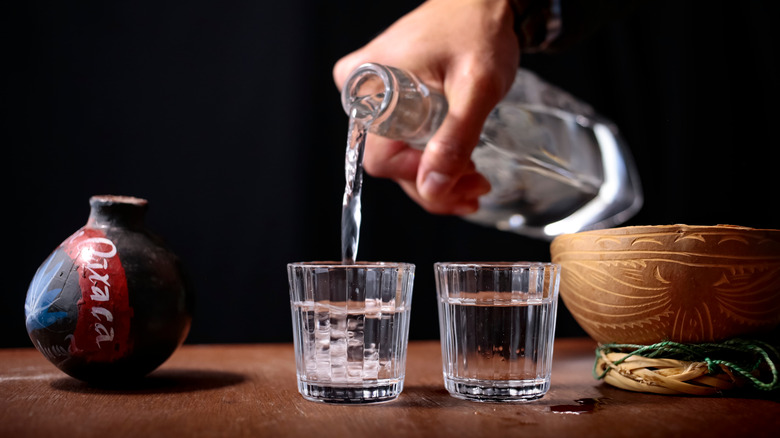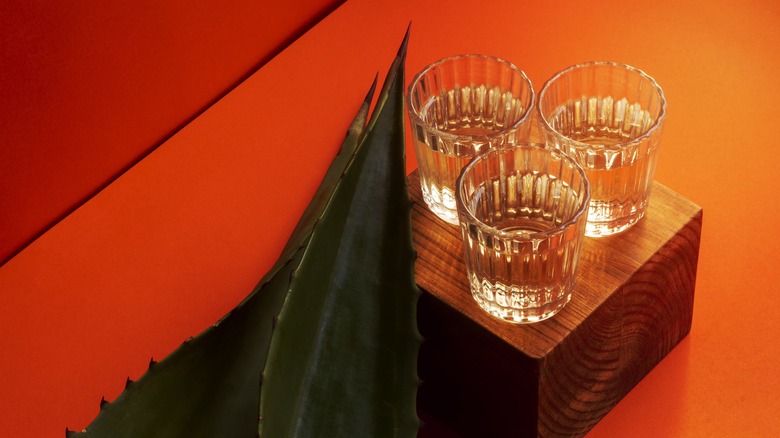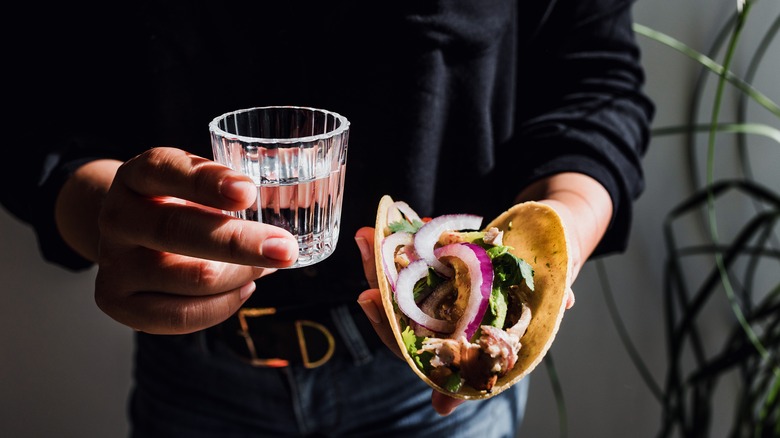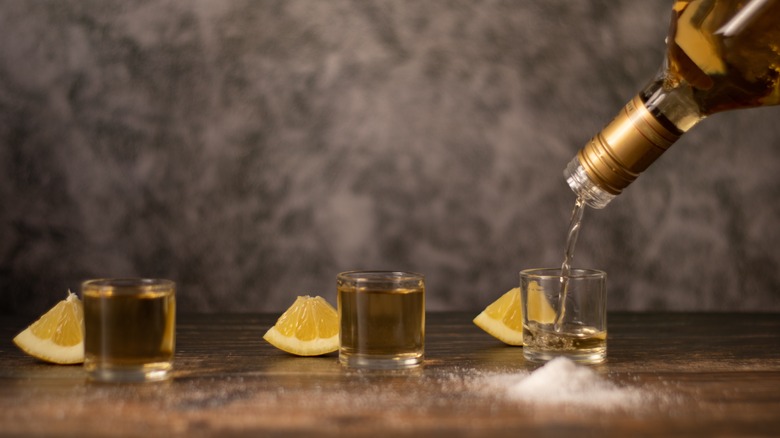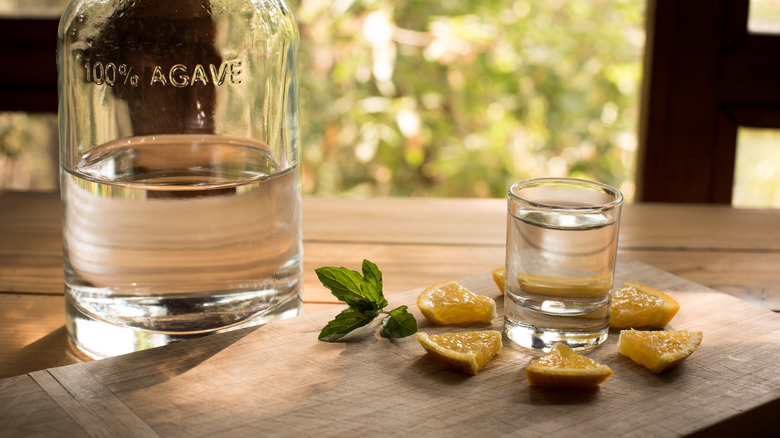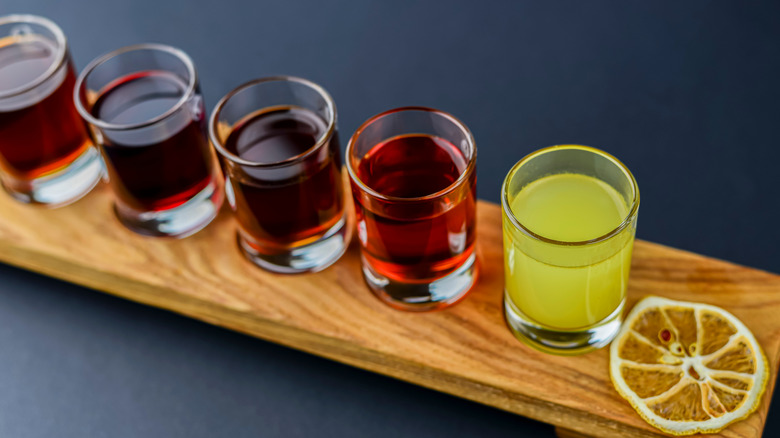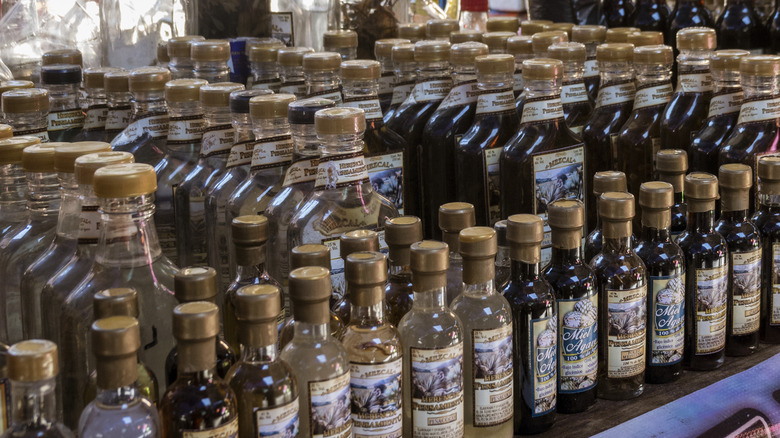What Is Mezcal And How Do You Drink It?
Mezcal is mysterious, smoky, and, well, a little misunderstood. Often associated with bottles featuring a signature worm, which is actually a larva, the drink is considered the more distinctive cousin to the ever-popular tequila. Mezcal, like tequila, is made from roasted agave plants. However, there is more to mezcal than tequila, literally. That's because tequila is a type of mezcal, made from only blue agave plants. Meanwhile, mezcal can be made from various types of agave. Its production is regulated by Mexico's Consejo Regulador del Mezcal. The drink holds significant cultural importance in Mexico and has a long and storied past dating back to the 16th century.
Mezcal features a stronger and smokier flavor than tequila and is often served neat. However, mezcal can also shine in a well-crafted cocktail. There really are no limits to what mezcal can do, so long as you understand its history, craft, and varieties.
How Is mezcal made?
Making mezcal is an extensive process, to say the least, and exact production methods vary by region and producer, however, it always starts with agave. Mezcal is made by harvesting agave, a large succulent plant native to the Americas, and cutting it down to its core, or piña. The piñas are roasted to release their natural sugars and are then fermented.
Fermentation is initiated by mashing the roasted pinas and combining the mixture with yeast and water to kick off the fermentation process. After sitting for several days to a few weeks, depending on the producer, the mixture turns to alcohol. However, this is far from the end of mezcal's journey to becoming, well, mezcal.
This is where distillation comes in, and it's a two-part process to create mezcal. If the mixture is only distilled once, it's labeled as ordinario and contains about 20–25% ABV. To make mezcal, ordinario is distilled a second time. This was traditionally done in clay or wooden stills heated by fire, but more industrial mezcal producers use metal containers, however.
After its distillation, mezcal is typically aged. However, the exact resting period varies based on the type of mezcal. Some mezcal is not aged after distillation, while other types of mezcal are aged for several years, producing a smoother and more complex liquor.
Mezcal vs. tequila
All tequila is mezcal, but not all mezcal is tequila. It's kind of a square and rectangle situation. Mezcal and tequila are both made from the agave plant using similar processes, however, tequila is only made from the blue agave plant, while mezcal can be made from a variety of agave plant types.
But it's not just the agave plant that makes the difference, mezcal and tequila also differ in taste. Tequila tends to have a spicier flavor, while mezcal is smoky, with earthy undertones. Additionally, tequila is required to age for at least two months, whereas mezcal is not. And though it varies, mezcal also typically features a higher alcohol content than tequila. Ultimately, these two liquors are far from interchangeable, even though they are related.
Mezcal is often served neat and sipped as you would a bourbon, because of its strong, signature flavor. However, it can also make for an interesting alternative to whiskey in certain cocktails.
What does mezcal taste like?
So, beyond its signature smokiness, what does mezcal taste like? The answer is: It varies. Mezcal is produced in a variety of different methods and from a variety of different agave plants. Early on, after its initial introduction to consumers in the United States, mezcal had a reputation for tasting like gasoline. However, this reputation is unfair and does not factor in the wide variety of mezcal production methods and flavor profiles.
Mezcal can contain a wide variety of flavors, impacts by the soil used to grow the agave plant, the agave type, the aging time, and more. Mezcal is typically smoky, but it can also contain floral, citrus, jalapeno, and even licorice notes. Mezcal can even feature a subtle flavor, depending on the brand and producer. It's definitely worth taking the time to taste different types of mezcal in order to fully appreciate the variety and complexity inherent to the liquor.
How To Cook With Mezcal
Mezcal is perhaps not the first alcohol you'd go to when cooking. However, the drink can prove to be a fantastic addition to several recipes. Adding mezcal to oysters can help to bring out the seafood's briny flavor. The drink can also be used as an interesting marinade for meats such as chicken.
Beyond food, however, mezcal can make a fantastic addition to your cocktail game. An Oaxacan old-fashioned, for example, brings together tequila and mezcal in a unique taste on a signature cocktail. Mezcal can also be added to a negroni, in place of the floral gin. The key here is to experiment and focus on bringing out the core flavors of your mezcal. Any drink or recipe that calls from complex flavors including smoke would be a fertile ground for mezcal experimentation. Pairing mezcal with chipotle-infused chocolate, for example, can make for a fascinating combination.
Where to buy mezcal
Though mezcal is not quite as ubiquitous in the United States as its blue agave subtype tequila, the drink is becoming more widely available in both bars and liquor stores. Mezcal can be purchased at most liquor stores, or at your local grocery store depending on your state's laws.
Mezcal may also be purchased online and shipped to you. In fact, you'll likely find a wider selection to choose from online as many online retailers carry mezcal varieties that are not readily available at in-person locations. But before shelling out the cash to buy a whole bottle of mezcal, trying a mezcal-based cocktail at your local bar or Mexican restaurant might be a good place to start. It might also be worth checking out which bars offer mezcal flights and tastings, to help you get better acquainted with the newly trendy, but historied liquor.
Nutritional information about mezcal
Mezcal is not exactly an essential part of your daily meal plan. The liquor does not contain a significant amount of either protein or fat, which are essential macronutrients. This is because mezcal derives most of its calories from alcohol. However, mezcal is relatively low in carbohydrates, making it a solid alcohol choice for someone adhering to a keto or low-carb diet. Though it may vary, mezcal is approximately 100 calories per 1.5 ounce serving. This is about the same as liquors such as vodka. The liquor pops a high dose of alcohol, having an ABV that typically hovers between 40 and 45% ABV.
Additionally, mezcal is not a significant source of vitamins or minerals. However, it can contain trace amounts of certain substances such as potassium, zinc, and magnesium. But these are not found in nutritionally significant amounts.
Varieties of mezcal
The world of mezcal is extremely diverse, varying in agave uses to distillation methods and aging time, and there really is so much mezcal to explore. However, there are a few key guiding posts to keep in mind which can help you navigate your mezcal journey.
First, mezcal is typically divided into three subsets: Mezcal, Mezcal Artesanal, and Mezcal Ancestral. Mezcal, the first subset, is produced in the most industrial manner. This type is typically fermented in stainless steel containers and uses more high-tech methods of creating traditional Mexican alcohol. Mezcal Artesanal, on the other hand, is a bit less industrial. However, production methods tend to vary. Mezcal Artesanal is typically roasted in earthen pits or clay ovens. Additionally, it is distilled in pots made of clay, copper, or wood. Mezcal Ancestral is the most traditional of the three types. Its production methods are limited to the extremely traditional, being fermented only in pit-type ovens. Distillation for Mezcal Ancestral can only be done in traditional clay pots heated by fire.
Additionally, mezcal is also differentiated by its age. There are four subcategories for mezcal by age. Blanco or joven mezcal, for example, is unaged mezcal. Reposado mezcal is typically aged for twelve months. Meanwhile, añejo mezcal is aged in wooden containers for at least one year. And Madurado de Vidrio mezcal is aged in glass for one year after distillation.
How to store mezcal
Mezcal, like many liquors, should be stored in a cool, dry place. Mezcal should be stored away from sunlight in order to prevent the liquor from dulling in flavor. So popping your mezcal in a closed liquor cabinet is the perfect choice for the drink.
Mezcal does not spoil, thanks to its high alcohol content. Additionally, the liquor tends to age slowly, so as long as you store your bottle properly you can count on it keeping for at least a few years. However, mezcal may dull in flavor over time. And if your drink smells off, or has changed in flavor, it's probably best to toss your bottle.
Mezcal, with its varied flavor profiles and unique production methods, can make a great addition to your liquor cabinet. Exploring the highly traditional Mexican liquor can help you fully appreciate the work and regulation that goes into making the often overlooked liquor. So next time you order a margarita, you might want to swap your tequila for a shot of mezcal.
